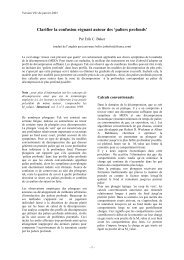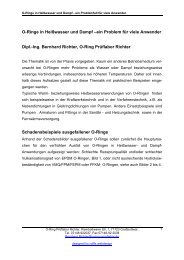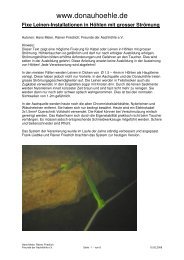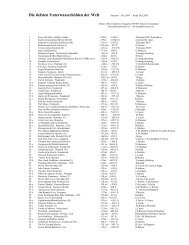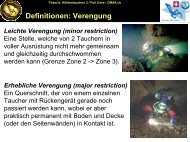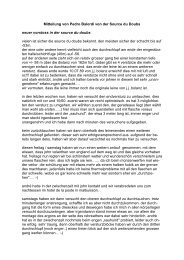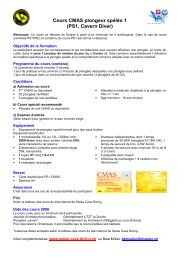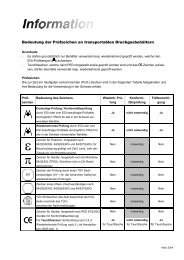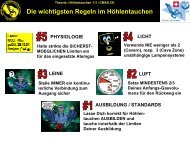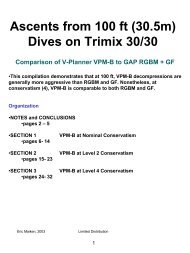cave diving and the nss - bei Swiss-Cave-Diving
cave diving and the nss - bei Swiss-Cave-Diving
cave diving and the nss - bei Swiss-Cave-Diving
You also want an ePaper? Increase the reach of your titles
YUMPU automatically turns print PDFs into web optimized ePapers that Google loves.
34 CAVE DIVING COMMUNICATIONS<br />
TOUCH CONTACT 35<br />
due to a multiplicity of reasons, <strong>and</strong> it can deteriorate gradually or<br />
instantaneously. In large <strong>cave</strong>, it is usually easy to swim without<br />
stirring up any silt at all. If silt is accidentally disturbed, <strong>the</strong> damage<br />
will not usually be as extensive, <strong>and</strong> <strong>the</strong> divers will have a lot more<br />
time to react—to get to <strong>the</strong> line <strong>and</strong> tighten up formation.<br />
In small <strong>cave</strong> passages, however, silting can be a much<br />
greater problem. In <strong>the</strong>se close quarters, even a single careless<br />
fin stroke may completely destroy <strong>the</strong> local visibility. In very low,<br />
clayey areas, it may be impossible, despite <strong>the</strong> most careful technique,<br />
not to completely blitz out <strong>the</strong> passageway. But while very<br />
tight areas do pose many significant problems—for silting, turning,<br />
attempting to signal <strong>and</strong> h<strong>and</strong> sign, etc.—<strong>the</strong> divers will usually be<br />
swimming much closer to <strong>the</strong> line. Of course, this poses its own<br />
hazards, in terms of line entanglements. The divers will also usually<br />
be moving much more slowly, <strong>and</strong> <strong>the</strong>refore, be closer toge<strong>the</strong>r.<br />
Where silting can easily <strong>and</strong> quickly become a problem, it<br />
makes sense to swim within arm's reach of <strong>the</strong> line. At <strong>the</strong> first<br />
sign of significant, rapid silting, it may be prudent to immediately<br />
make an encircling "Okay" sign around <strong>the</strong> line, even though you<br />
still have several feet of visibility.<br />
If <strong>the</strong> visibility does decrease<br />
to zero or near zero, <strong>the</strong> team<br />
members should get into physical<br />
contact with each o<strong>the</strong>r. The lead<br />
diver should pause while <strong>the</strong> trailing<br />
divers close up <strong>the</strong> ranks, each<br />
diver firmly gripping <strong>the</strong> arm or leg<br />
of <strong>the</strong> diver in front of him, while<br />
maintaining an "Okay" around <strong>the</strong><br />
line. Although it may be necessary<br />
occasionally to release one's grip<br />
on <strong>the</strong> diver ahead in order to adjust<br />
buoyancy or to feel for obstacles<br />
in tight quarters, you should<br />
o<strong>the</strong>rwise try to maintain constant<br />
contact. Whe<strong>the</strong>r or not <strong>the</strong> dive is<br />
turned depends upon <strong>the</strong> experience<br />
level of <strong>the</strong> team, <strong>the</strong> conditions<br />
<strong>the</strong>y were anticipating, <strong>and</strong><br />
many o<strong>the</strong>r factors. Whereas<br />
<strong>cave</strong>rn divers <strong>and</strong> <strong>cave</strong>-<strong>diving</strong> students<br />
are required to turn dives<br />
when visibility drops below acceptable<br />
minimums, fully trained, experienced<br />
<strong>cave</strong> divers may choose to<br />
proceed with exploration despite<br />
temporary drops in visibility. This<br />
method of keeping in touch your<br />
dive partner while maintaining contact<br />
with <strong>the</strong> line is referred to as<br />
"touch-contact." With it some basic<br />
communication is also possible.<br />
The basic touch-contact signals<br />
are "Stop," "Go," <strong>and</strong> "Back<br />
up." If <strong>the</strong> rear diver pushes on <strong>the</strong><br />
lead diver's arm or leg, it means,<br />
"Go" (<strong>and</strong> also, implicitly, is signalling<br />
that he's okay). If he pulls, it<br />
means, "Stop." Successive pulling<br />
movements mean, "Back up." If<br />
"Sharing Air with<br />
Touch-Contact on<br />
<strong>the</strong> Line"




